
A cactus is a member of the plant family Cactaceae, a family comprising about 127 genera with some 1750 known species of the order Caryophyllales. The word cactus derives, through Latin, from the Ancient Greek word κάκτος (káktos), a name originally used by Theophrastus for a spiny plant whose identity is now not certain. Cacti occur in a wide range of shapes and sizes. Although some species live in quite humid environments, most cacti live in habitats subject to at least some drought. Many live in extremely dry environments, even being found in the Atacama Desert, one of the driest places on earth. Cacti show many adaptations to conserve water. Almost all cacti are succulents, meaning they have thickened, fleshy parts adapted to store water. Unlike many other succulents, the stem is the only part of most cacti where this vital process takes place. Most species of cacti have lost true leaves, retaining only spines, which are highly modified leaves. As well as defending against herbivores, spines help prevent water loss by reducing air flow close to the cactus and providing some shade. In the absence of leaves, enlarged stems carry out photosynthesis. Cacti are native to the Americas, ranging from Patagonia in the south to parts of western Canada in the north—except for Rhipsalis baccifera, which also grows in Africa and Sri Lanka.
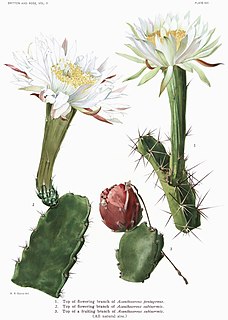
Acanthocereus is a genus of cacti. Its species take the form of shrubs with arching or climbing stems up to several meters in height. The generic name is derived from the Greek word άκανθα (acantha), meaning spine, and the Latin word cereus, meaning candle. The genus is native to the mostly tropical Americas from Texas and the southern tip of Florida to the northern part of South America, including islands of the Caribbean.

Epiphyllum is a genus of epiphytic plants in the cactus family (Cactaceae), native to Central America and South America. Common names for these species include climbing cacti, orchid cacti and leaf cacti, though the latter also refers to the genus Pereskia.

Disocactus is a genus of epiphytic cacti in the tribe Hylocereeae found in Central America, the Caribbean and northern South America. It should not be confused with Discocactus, which is a different genus.

Aporocactus is a genus of cacti in the tribe Hylocereeae native to Mexico. It used to be classified as a subgenus in Disocactus, but according to molecular evidence, it should be excluded from Disocactus and treated as a separate genus.
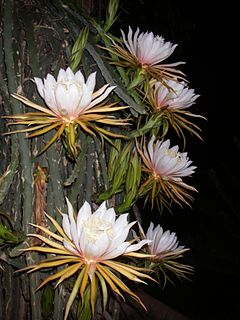
Hylocereus is a former genus of epiphytic cacti, often referred to as night-blooming cactus. Several species previously placed in the genus have large edible fruits, which are known as pitayas, pitahayas or dragonfruits. In 2017, a molecular phylogenetic study confirmed an earlier finding that the genus Hylocereus was nested within Selenicereus, so all the species of Hylocereus were transferred to Selenicereus.

Selenicereus, sometimes known as moonlight cactus, is a genus of epiphytic, lithophytic, and terrestrial cacti, found in Mexico, Central America, the Caribbean and northern South America. The term night-blooming cereus is also sometimes used, but this is also used for many night-blooming cacti, including Epiphyllum and Peniocereus. In 2017, the genus Hylocereus was brought into synonymy with Selenicereus. A number of species of Selenicereus produce fruit that is eaten. The fruit, known as pitaya or pitahaya in Spanish or as dragon fruit, may be collected from the wild or the plants may be cultivated.

Weberocereus is genus of cacti. It produces a green and white flower and is found mainly in Costa Rica and Nicaragua.

Deamia is a genus of cacti. Its species are native from south Mexico through Central America to Nicaragua. Its species have been placed in Selenicereus and Strophocactus.
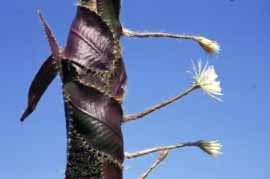
Strophocactus is a genus of cacti in the subfamily Cactoideae. Its status and circumscription remain somewhat uncertain, with the genus containing one to three species. Molecular phylogenetic data suggest that it consists of three species, including two formerly comprising the genus Pseudoacanthocereus. With this circumscription, the species have different growth habits, but share similarities in their flowers, which are white and open at night.
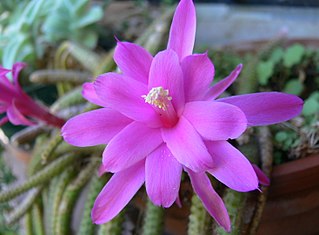
Aporocactus flagelliformis, the rattail cactus, is a species of flowering plant in the cactus family Cactaceae, and is the most cultivated species in the genus Aporocactus. Due to its ease of cultivation and attractive floral displays, it is often grown as an ornamental potted plant.

Disocactus anguliger, commonly known as the fishbone cactus or zig zag cactus, is a cactus species native to Mexico. The species is commonly grown as an ornamental for its fragrant flowers in the fall.
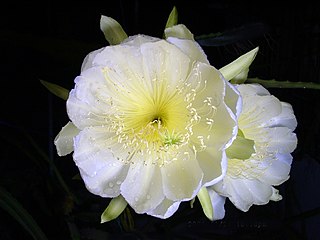
Selenicereus megalanthus, synonym Hylocereus megalanthus, is a cactus species in the genus Selenicereus that is native to northern South America, where it is known, along with its fruit, by the name of pitahaya. The species is grown commercially for its yellow fruit, but is also an impressive ornamental climbing vine with perhaps the largest flowers of all cacti.

Strophocactus brasiliensis, synonym Pseudoacanthocereus brasiliensis, is a species of plant in the family Cactaceae. It is endemic to Brazil. Its natural habitats are subtropical or tropical dry forests and hot deserts. It is threatened by habitat loss.

The Hylocereeae are a tribe of cacti. Most are found in the tropical forests of Central and northern South America, and are climbers or epiphytes, unlike most cacti. The tribe includes between six and eight genera in different circumscriptions. The plants known as "epiphyllum hybrids" or "epiphyllums", widely grown for their flowers, are hybrids of species within this tribe, particularly Disocactus, Pseudorhipsalis and Selenicereus, less often Epiphyllum, in spite of the common name.

Strophocactus wittii, synonym Selenicereus wittii, known as the Amazon moonflower, is a species of plant in the genus Strophocactus in the cactus family (Cactaceae), and is one of several species commonly called "moonflowers". It was first described in 1900 and is one of three species of cactus found in the central Amazon basin.
Strophocactus sicariguensis, synonym Pseudoacanthocereus sicariguensis, is a species of plant in the family Cactaceae. It is native to Colombia and Venezuela. It has often sprawling thin stems and white funnel-shaped flowers that open at night.

Kimnachia is a monotypic genus of cacti. Its only species is Kimnachia ramulosa, synonym Pseudorhipsalis ramulosa, which is native from southern Mexico to northern South America and also found in Jamaica.

Deamia testudo is a species of flowering plant in the family Cactaceae, native from southern Mexico through Central America to Nicaragua. It was first described in 1838. It is a climber or clamberer, with long stems and large white flowers.
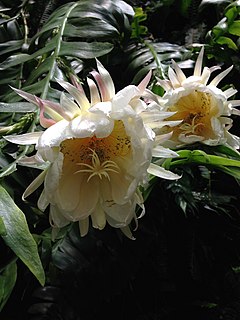
Epiphyllum chrysocardium is an epiphytic cactus native to Mexico. It used to be the only species in the genus Chiapasophyllum or one of the species in the genus Selenicereus, but molecular phylogenetic studies show that it belongs to Epiphyllum.




















